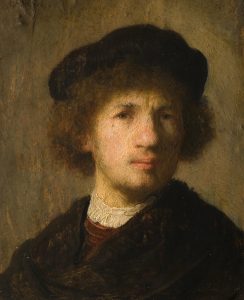
Rembrandt, Self Portrait.
I have been working behind the camera for over 40 years and I have spent more of my career lighting interviews than anything else! Amongst other things I spent 22 years shooting Panorama for the BBC, and before that, worked on shows like World in Action as well as numerous other interview driven documentaries. I have interviewed Presidents, Royalty, Prime Ministers, addicts, victims, the abused, celebrities, cops, robbers, soldiers… really, every type of person from every walk of life. I don’t know how many interviews I have lit but it certainly runs into the several hundreds and probably thousands! Interviews are the core to much of a documentary camerapersons work.
I should point out from the start that this article is about my approach to lighting an interview. I’m sure that there will be those of you out there who may tut-tut and say “ooh, I wouldn’t do it like that, I would do it like this” – and you may be right! The point is that we all approach lighting in different ways, but we all get the job done! For the less experienced practitioners, however, understanding the difference between illumination and lighting, and what makes lighting to be considered “good” is what I hope to explore here.
I originally studied vocational photography at Plymouth College of Art, where I learned to light portraits in a classical way. As a rule of thumb we were taught to light a traditional portrait with three lights – a key light, a fill light and a backlight. We were encouraged to key more from the side to allow the shadow of the nose to merge into the shadow on the side of the face, yet still allowing the light to “see” the eye away from the light. This gives a triangle of light on the darker side of the face, with a highlight in both eyes. I call this portrait lighting, but these days it’s often somewhat pretentiously called Rembrandt Lighting – but if you study Rembrandt you can see why!
But – is there a correct way to light an interview? Well, no, there isn’t. There are so many factors which influence the lighting of an interview: First – how many cameras are you lighting for? Are you lighting a single face, two faces? Is the background important? What other light sources are visible? Can you incorporate practical lighting into your set? Is the background light going to change during the course of the interview? What kind of documentary are you lighting for – is there a style or mood? And, of course, what lights do you have with you?
Once on location my approach first and foremost is to find the shot! Work out where the best angle is to shoot the interview given the parameters mentioned in the previously mentioned, and then set about the lighting.
My main problem with lighting is lugging it around. These days I invariably work on my own, burdened with multiple cameras, sound and lighting kit. My attitude to everything here is to keep it simple. That is the advantage of experience. Thirty-five years ago I would use what was called a BBC “C” kit. In those days you had to use a spark to do the lighting, and a single spark was allowed to use 4kws of light. There were various “kits” that you could choose from, and I used a “C” kit which consisted of a Blonde (2Kw open face), a Redhead (1kw open face) and 2 mizars (300w Fresnel). An “A” Kit was two blondes, a “B” kit 1 blonde and two redheads etc. The “C” kit gave me flexibility of five heads yet staying inside the 4Kw remit. If you wanted or needed HMIs then that usually meant two sparks, and because of the size of the lamps, ballast and stands, setting everything up slowed everything down. Although in those days we were shooting film, and rarely shot more than 40 minutes of material a day because of the cost of film stock, so arguably that gave us more time to play with.
35 years ago nice soft boxes didn’t exist – they had to be made on set using either a sheet of poly or using trace frames, plus all the flags and so on, to control the spill. It always ended up being a bit major, but you did get a spark. Then, in the late 1990’s, space age materials began to appear, most notably kevlar, and with it the advent of the heat resistant Chimera soft box. Literally a game changer. This bit of kit now allowed the use of a controllable soft light that was easy to set up and very manageable. Put in front of a redhead with an eggcrate and you could control all of your spill light, and the set up would be around the size of a 2×1 ft soft box that we see today, albeit deeper. Add a couple of dedo lights – one lighting the background, and one as a back light, and off you go. The Dedos were good because they were both versatile and compact.
Over the last 20 years the prevalence of Chimera soft boxes has given way to the emergence of first, Kino-flo type fluorescent tube lights (which don’t really get hot), then LED panel lights. We have also seen, more recently, COB (chip-on-board) LED lights (Aputure 60D, Nanlite Forza 150 etc) which just seem to get more and more powerful as the technology improves, and they are far more compact than equivalent output HMI’s. These COB lamps are now embracing the Bowens mount standard for lighting accessories, and because they don’t get hot (compared to a redhead) you can use the same tools a stills photographer might use when he’s using studio flash systems. Indeed, the Bowens flash system is what I used at college all those years ago, when we could use soft boxes for stills photography because heat wasn’t an issue as we were shooting flash. Now you can use these COB fixtures behind 2ft, 3 ft 4ft and bigger Octadomes which give you have a very flexible system! If I really want to travel with a super portable, compact lighting package, I just take a small COB light and perhaps a 3ft octabox.
I always key the side of the face on the side that is looking (so if left to right eyeline then the key goes on the right). This is because the key light, behind its soft box, can be positioned quite close the the subject, and the closer to the subject the more the light wraps around the face. The backlight positioned on the opposite side to the key and set so that the light “kisses” the dark side of the face, but carefully positioned so the light doesn’t spill onto the end of the nose! I give the backlight around one half to one stop less exposure than the key (but this depends on backgrounds and a multitude of other things). This creates a separation for the interviewee from the background and it also acts as a bit of a fill light on the dark side of the face. By getting the balance right the subject now looks naturally lit, as if by a window. Notice, though, that I have made no reference to the fill light, this is because if lit properly you don’t really need one.
To me, the crucial thing with lighting this way is that you get a single highlight in the eye. To me that is the gold standard. As you move the key light away from the subject, the wrap round effect decreases and the light becomes more of a point light source with harder shadows, and this can be effective for some types of interview. I dislike lighting that comes straight over the top of camera – it is flat and uninteresting, and you always end up with an ugly little shadow below the nose and above the lip. I want the lighting to look natural with shape, contrast and mood. If the shadow side of the subject is a little dark I may drop in a white reflector to kick a little bit back into that side of the face.
It is worth studying different lighting techniques – or styles of lighting. A lot of interviews are shot with lights over the camera, a lot are shot the way that I describe above. More theatrical type lighting is done with hard rather than soft light, but the principle remains. Using a soft light close to the subject (around two feet away) gives a wraparound light, but used too far away from the subject it becomes a diffused hard light. One of the many advantages to using soft wrap around lighting is that shadows more or less disappear for people wearing glasses, and older more wrinkled faces appear softer and smoother.
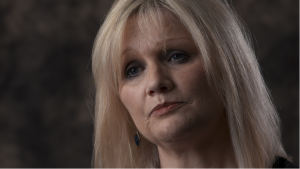
Contributor interview, 5 foot umbrella key lit by Stella Prolight, Aladdin 1×1 backlight, background from key light spill
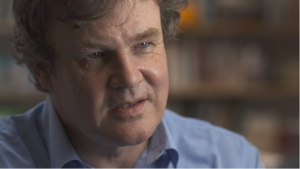
Contributor interview, 2×1 Aladdin LED panel, Manfrotto Lykos backlight, background ambient light
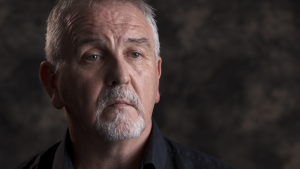
Contributor interview, 5ft Umbrella key light, Manfrotto Lykos backlight, background spill from key
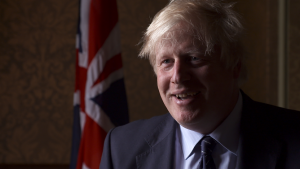
Boris Johnson, available light from large window, Foreign Office, Whitehall
My advice is to experiment. Buy a polystyrene mannequin head from eBay and see how the light changes as you move it – use a 2×1 soft box two feet away, then try 4 feet, then 8 feet. You’ll be surprised how much the mood from that single light source changes. Watch interviews on the TV and decide what type of lighting you like. Most importantly, just remember that throughout your career, you never stop learning.
To finish, I will tell you that my standard lighting kit is this: A 2×1 Aladdin LED panel light for the key, a 1×1 Aladdin Led panel for a backlight, a Nanlite Forza 60B (COB) with lenses for a flexible third light, a Stella Prolight (COB) which is a bit outdated now, and a 3’ Octadome which I can use with it. I seldom use more than three lamps.
